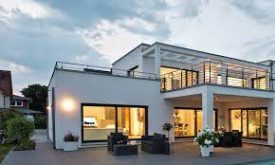Bauhaus architecture originated in Germany in the early 20th century and is characterized by its focus on functionality, simplicity, and the use of modern materials such as steel and concrete. A Bauhaus villa is a type of home that is designed in this style and typically features clean lines, minimal ornamentation, and an emphasis on open spaces and natural light. Here are some key features of a Bauhaus villa.
Minimalism
Bauhaus villas are known for their minimalistic design. They typically feature simple geometric shapes and clean lines, with a focus on function over form. The idea is to create a space that is both aesthetically pleasing and practical, without the need for excessive ornamentation or decoration.
Open Plan Living
Another characteristic of a Bauhaus villa is the emphasis on open-plan living. The use of large windows and open spaces allow for natural light to flood the interior, creating a bright and airy atmosphere. The layout is designed to promote flow and movement, with spaces that seamlessly transition from one area to the next.
Functionality
Bauhaus architecture is all about function over form, and this is evident in the design of a Bauhaus villa. Everything from the layout to the furniture is carefully considered to ensure maximum functionality. The focus is on creating a space that is efficient and practical, without sacrificing style or comfort.
Use of Modern Materials
Bauhaus architecture is characterized by the use of modern materials such as steel, concrete, and glass. These materials are chosen for their durability, strength, and versatility. They are also used to create a sense of transparency and openness, with large windows and glass walls that blur the line between interior and exterior spaces.
Integration with Nature
Despite their focus on modern materials, Bauhaus villas are also designed to integrate with nature. The use of large windows and open spaces allows for a seamless connection between the interior and exterior, with views of the surrounding landscape becoming an integral part of the design. Outdoor living spaces such as patios and terraces are also common in Bauhaus villas. Providing additional areas for relaxation and enjoyment.
Simple Color Palette
Bauhaus villas typically feature a simple color palette, with neutral tones such as white. Black, and gray are the most common. This allows the focus to remain on the architecture and design of the space, without the distraction of bold colors or patterns.
Streamlined Furniture
The furniture used in a Bauhaus villa is typically streamlined and functional. With a focus on simple shapes and clean lines. Pieces are chosen for their practicality and efficiency, rather than their decorative value. The idea is to create a space that is uncluttered and free of unnecessary objects, allowing for maximum flow and movement.
Innovative Lighting
Lighting is a key element in Bauhaus architecture, with innovative lighting solutions often being incorporated into the design of a villa. The use of recessed lighting, track lighting, and other types of modern fixtures allows for the creation of unique and dynamic lighting effects that enhance the overall aesthetic of the space.
In conclusion, a Bauhaus villa is a type of home that is designed with functionality. Simplicity and modern materials are in mind. With a focus on open-plan living, minimalism, and the integration of nature, these homes provide a bright, airy. And efficient living space that is both aesthetically pleasing and practical. From the use of modern materials to streamlined furniture and innovative lighting. Every element of a Bauhaus villa is carefully chosen to create a harmonious and functional living environment.

